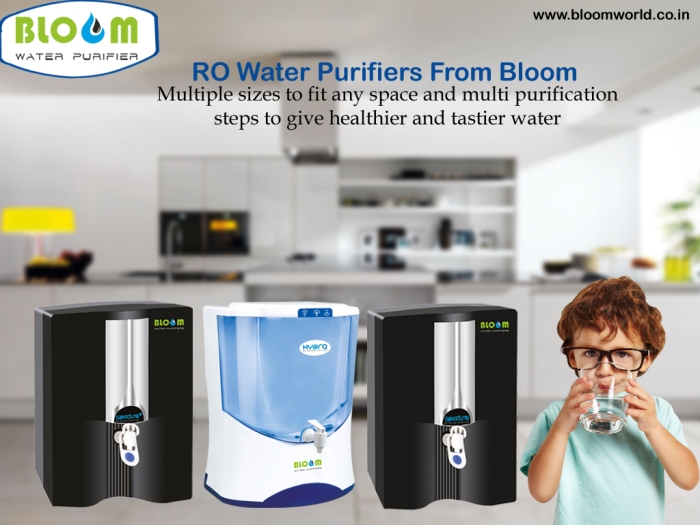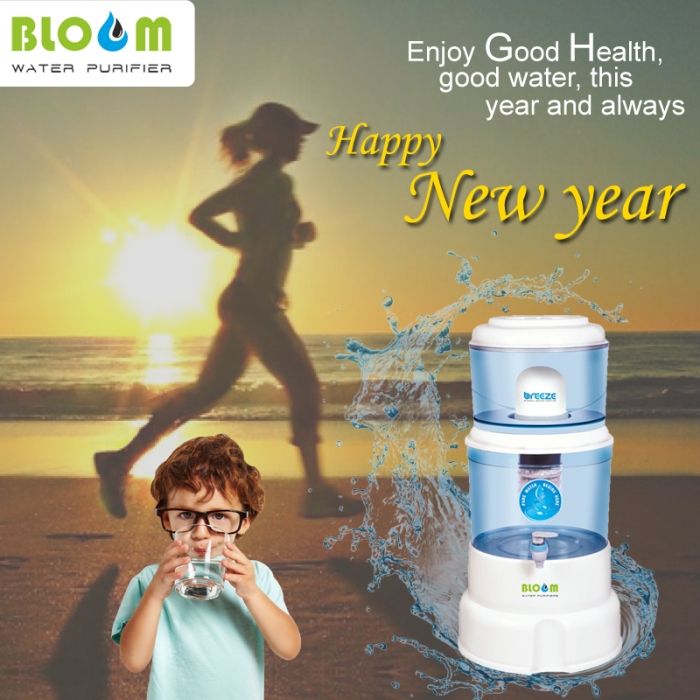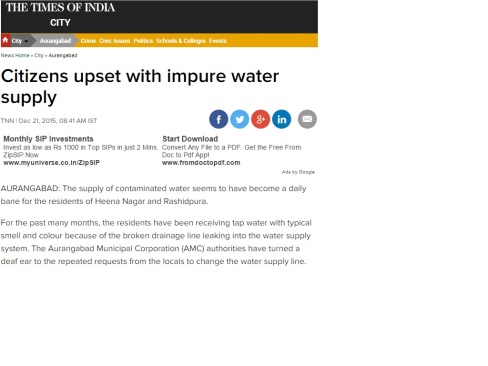Water has many benefits. But this colourless odourless liquid had a tendency to dissolve many impurities in it. These impurities not only make the water unfit for consumption, but also leads to various water borne diseases like jaundice, cholera etc. At times these diseases become life threatening. To keep your family safe and healthy choose Bloom water purifiers. These purifiers are designed with multi stage purification process so that every glass of water you get form it is pure as safe.
Bloom Water Purifier
Protect your family from waterborne diseases: Switch to Bloom water purifiers
Water has many benefits. But this colourless odourless liquid had a tendency to dissolve many impurities in it. These impurities not only make the water unfit for consumption, but also leads to various water borne diseases like jaundice, cholera etc. At times these diseases become life threatening. To keep your family safe and healthy choose Bloom water purifiers. These purifiers are designed with multi stage purification process so that every glass of water you get form it is pure and safe.
For more details:
Government allots Rs 1,000 crore for toxic water zones
NITI Aayog will provide Rs 1,000 crore to save a large population in various states where people are forced to consume groundwater that contains excess of health-crippling arsenic and fluoride.
The plan is to install community water purification plants (CWPPs). Each of which would provide 1,000 litres of drinking water an hour for which users will have to pay 10 paise per litre. Groundwater contamination – also including that of iron, salinity and nitrate – has become a serious public health crisis, particularly in rural pockets, affecting over 3.61 crore people in 63,831 pockets across half of India’s districts, latest government data shows.
In 2013, five crore people in over one lakh rural habitations did not have access to safe drinking water. While excess fluoride content can lead to fluorosis, which affects teeth and bones, excess arsenic leads to skin problems, hits the nervous system and reduces IQ level among children. It can also cause cancer.
However, the government’s own policy says a person should get at least 40 litres of water a day. “This would be an interim and shortterm measure,” a top government official told Mail Today on Tuesday. The government has released Rs 2,758.45 crore to states in the current fiscal to provide safe drinking water in rural areas. It also aims to cover 90 per cent of the rural population through piped supply schemes by 2022. The decision to install CWPPs was taken after the Ministry of Drinking Water and Sanitation (MDWS) and India’s think-tank and policy forum on December 15 held a video conference with 14 major arsenic and fluorideaffected states like Andhra Pradesh, Assam, Bihar, Chhattisgarh, Karnataka, Kerala, Madhya Pradesh, Maharashtra, Odisha, Punjab, Rajasthan, Telangana, Uttar Pradesh and West Bengal.
While NITI Aayog would fund only the capital cost of CWPPs, the states some of which have already installed CWPPs, would ensure their operation and maintenance for at least seven years. They would also have to provide raw water sources, structures and electricity to run these plants. Pockets across 276 districts have excess fluoride in groundwater. At least 387 districts, of the 676 in the country, have nitrate above permissible levels. Pockets in 87 districts have high arsenic content. This is even more serious because in rural India facilities to deal with health problems arising out of water contamination are extremely poor.
Top two worst-affected states in terms of overall contamination are Rajasthan (86,83,403 people in 21,927 pockets) and West Bengal (89,74,986 people in 10,807 pockets), government data as on December 2015 shows. Purely in terms of fluoride, Rajasthan has 43.74 lakh affected people in 6,904 pockets. For Karnataka, the number stands at 7.79 lakh people in 1,044 pockets.
States such as Punjab and Assam are facing both arsenic and fluoride problems. Drinking water supply is a state subject but MDWS provides financial and technical assistance. Yet the policy of 40 litres per person per day is working only in 12,89,057 habitations out of a total of 17,13,003 in the country while 3,60,415 are partially covered. Water expert Himanshu Thakkar says depletion of groundwater levels, due to excess use and destruction of recharge systems, leads to contamination. Rainwater harvesting is the most cost effective and appropriate option. “Underground storages can also be considered,” he adds.
Expert view
Manoj Misra, another expert, says much of this contamination is also industry generated. “Why should the tax payer be made to foot the bill? We must ask these tough questions before a quantum shift in rural drinking water supply is attempted,” he says. Nearly 80 per cent of India’s rural drinking water comes from underground sources. The plan’s emphasis is to shift from ground water to piped supply of surface water, minimising hand pump use.
Credits : http://indiatoday.intoday.in/story/govt-allots-rs-1-000-crore-for-toxic-water-zones/1/563439.html
Water purification plant set up
HAPPY NEW YEAR FROM BLOOM WATER PURIFIER
A Glass of Water brings you Ten million bacteria
Researchers discovered that a glass of water contains 10 million bacteria. It is good to know that there is a way to improve the quality of the water, Recently Researchers from Lunch University in Sweden found that these microscopic bacteria will grow inside the water pipes of Water treatment plant which looks in the form of a thin, sticky coating – a so-called biofilm. Experts are saying clean drinking water has 10 million bacteria, clean tap water has harmless bacteria,
A Glass of Water brings you Ten million bacteria
Also, researchers are saying that these organisms will stay in the place where water intake happens near the tap, pipes and in water purification plants.
Catherine Paul from Lund University in Sweden added, ” A previously completely unknown ecosystem has revealed itself to us. Formerly, you could hardly see any bacteria at all and now, thanks to techniques such as massive DNA sequencing and flow cytometry, we suddenly see eighty thousand bacteria per milliliter in drinking water.”
In the research it was found that at least two thousand different species will live in the water pipes. But researchers are saying that there is a link between the water quality and bacteria.
Paul is saying that, ” We suspect there are ‘good’ bacteria that help purify the water and keep it safe – similar to what happens in our bodies. Our intestines are full of bacteria, and most of the time when we are healthy, they help us digest our food and fight illness.”
So researchers are saying that keeping in mind about this bacteria go for the development of the water purifiers or water treatment plants across the world.
Finally, Paul mentioned in a statement, “The hope is that we eventually may be able to control the composition and quality of water in the water supply to steer the growth of ‘good’ bacteria that can help purify the water even more efficiently than today.”
Credits : http://www.belvoireagle.com/health/a-glass-of-water-brings-you-ten-million-bacteria-13221.html
Is our water a toxic cocktail?
HYDERABAD: Already reeling under an acute water shortage, Hyderabadis are now staring at a severe contamination crisis. Studies suggest that over 70% of the city’s piped Manjeera water, supplied to approximately 3 lakh homes, is contaminated and not fit for consumption.
The findings point to the high presence of contaminants like faecal coliforms, nitrates, chlorides, calcium and heavy metals such as cadmium all precursors of severe health complications in the water.In fact, a study published by the Osmania University’s research wing in April this year revealed that 40% of the city’s water supply is laced with heavy metals, and in many cases, even faecal matter.
Worse, a research paper published in September 2014 by a group of professors from universities across the state found the pH levels of water in the Hyderabad Urban Agglomeration (HUA) to be between 6.2 and 8.65.
“Lower pH means that the water is acidic, while higher pH means the water is alkaline, both of which are not safe. Besides, both these conditions can corrode water pipes, rendering them weak and eventually causing tear,” the paper reasoned.
Sadly, this isn’t a new concern. Hyderabad’s water quality has been deteriorating over the past few years.While until half a decade ago this crisis was restricted to urban slums like Bholakpur and Asif Nagar, it has now seeped into the city’s posh belts too: Madhapur, Banjara Hills, Jubilee Hills, apart from places like Secunderabad, Abids and Pragathi Nagar.
A study published by Eureka Forbes in 2013 had pointed to this alarming trend while highlighting the high presence of chlorides, nitrates, dissolved salts and other contaminants in the water all above permissible limits in various parts of Hyderabad.
“The water that we receive is sometimes smelly , discoloured or has a mossy green sediment. Despite having various `technologies’ in place that claim to purify the water, we still boil it before consuming it,” said Abhijeet Matthew, a resident of Banjara Hills Road No. 10.
Things aren’t any different in Cyberabad. “There is an oily layer floating on the water when we fill it straight out of the tap. Despite boiling the water, the smell or taste doesn’t seem to change. We had rented a house in this area hoping that we would be spared of these problems, but unfortunately that doesn’t seem to be the case,” said Pranay Dey , a resident of Kavuri Hills.
Citizens upset with impure water supply
This Water Purifier Provides Arsenic Free Water at Just 5 Paise a Litre: IIT-M’s Gift to the Nation
An affordable nano technology-based water purifier. The aim behind the purifier was to provide safe drinking water without any microbial and chemical impurities, and to fight the problem of arsenic contamination that leads to many health hazards.
The purifier has been in use at many places in West Bengal. Over four lakh people in the state have been enjoying arsenic-free water at just 5 paise per litre.
And now, the Union Ministry of Drinking Water and Sanitation has recommended its use and replication in all states that have been affected due to arsenic contamination.
The ministry has sent this information to IIT-M and has asked authorities in different state governments to visit the arsenic removal plant in Nadia district of West Bengal. They have been asked to replicate the technology with the help of funds provided by National Rural Drinking Water Programme. Arsenic in drinking water causes skin lesions, lung, bladder and skin cancer, and may lead to kidney and liver cancer too.
The research team behind this purifier was headed by Professor Thalappil Pradeep from the department of Chemistry. It is called AMRIT – Arsenic and Metal Removal through Indian Technology. The system does not need electricity or piped water supply. The only thing required for operation is gravity. It uses iron oxyhydroxide, which is a nanostructured material, to selectively remove arsenic when water is passed through it.
“Our technology produces water with arsenic concentration of less than 2 parts per billion,” Professor T Pradeep said.
The purification process takes place in two stages. First the microbial impurities are removed by killing them with a very small concentration of silver ions released from silver nanoparticles. After this, the chemical impurities like arsenic, lead, iron etc. are removed with the help of different nanomaterials that remove the chemicals one by one, in a selective manner. The purifier is adaptable to local conditions and the type of contamination.
It was first introduced in the villages of Murshidabad district in West Bengal after the Arsenic Task Force of the government of West Bengal certified and approved its use. There are two variants of the purifier. The larger unit that can provide 18,000 litres of pure water per hour has been installed in Nadiya District and the smaller, domestic version has been installed in several houses.
Credits :
http://www.thebetterindia.com/40216/isro-singaporean-satellites/
RO water purifiers from Bloom

It is good to choose the water purifier that suits your need and the quality of the water. Bloom offers you wide range of water purifiers and filters to choose from depending upon the quality of water. The water purifiers range offers you multiple choice in the stages of water purification. Water filters have the variety of option depending upon the size of the tank and filtration method. Move into the store and get the one that suits you best.
For more details:










